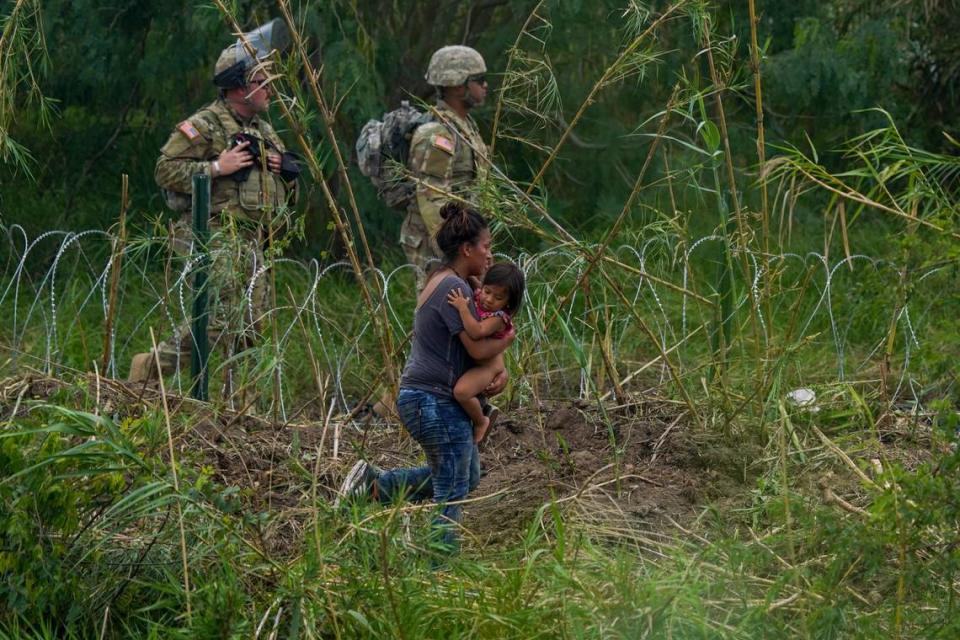New U.S. asylum restrictions will force many migrants to remain in Mexico, where they face discrimination
Haitian nationals are the largest group of political-asylum applicants in Mexico. But of the nearly 19,000 who have applied for protection to remain in the country this year, only 62 have been granted legal refugee status.
That low acceptance rate — compared to the 3,848 Hondurans who have already been granted protection as refugees by Mexican authorities this year — is one of the examples immigration advocates and aid workers point to when discussing their opposition to a new Biden administration rule that bans migrants from seeking asylum in the United States if they fail to first request it in another country they have traveled through.
The rule, which takes effect Friday, is part of a series of sweeping new measures that the administration has put in place as the pandemic-era emergency public health rule known as Title 42 comes to an end. Under the Trump-era policy, more than 2.8 million migrants were rapidly expelled from the United States’ southern border over three years.
Now, advocates say, instead of returning to the previous policy in which migrants could appear in person at a U.S. port of entry and request asylum, the United States will force them to choose between deportation and banishment or remaining in places plagued by the kind of violence and poverty they are fleeing, and without robust immigration protections.
“This asylum ban is nothing more than a rebranding of the harmful and racist policies of the Trump administration, which forced so many people and families, including children, into harm’s way,” said Abby Maxman, president and chief executive officer of Oxfam America. “Seeking asylum is a legal and human right — one that must not depend on which country you flee, the path of your journey to the United States, or your manner of entry.”

Kevin Keen, a spokesman with the United Nations High Commissioner for Refugees, said while the agency welcomes the end of Title 42, it finds that “key elements of the regulation are incompatible with principles of international refugee law.”
“The regulation will restrict the human right to seek asylum,” he said. “Seeking asylum is a fundamental human right.”
On Thursday as the clock winds down to the 11:59 p.m. deadline for the expiration of Title 42 and other COVID-19 health rules, Department of Homeland Security officials rejected the criticism that they were subjecting already vulnerable migrants to danger and violence.
“We hear these criticisms, but we do not agree with them,” said DHS Acting Assistant Secretary for Border and Immigration Policy Blas Nuñez-Neto in a press call with journalists. He insisted that under the new administration’s policies, “people still have the right to request asylum at the border.”
Nuñez-Neto said DHS is offering other ways to legally come to the U.S.. He and others have touted the success of more than 100,000 Haitians, Cubans, Nicaraguans and Venezuelans who have been allowed into the U.S. under a new humanitarian program.
“Like all countries, we have the need to enforce our laws at the border and we have also been working with all our partner countries in the region so they expand their legal channels for migrants and enforce their laws at their borders,” Nuñez-Neto said in the call, conducted in Spanish.
Secretary of Homeland Security Alejandro Mayorkas again emphasized that anyone arriving at the border without using a lawful pathway will face tougher consequences including a minimum five-year ban on re-entry and potential criminal prosecution.
“We are ready to humanely process and remove people without a legal basis to remain in the U.S. We have 24,000 Border Patrol Agents and Officers at the Southwest Border and have surged thousands of troops and contractors, and over a thousand asylum officers to help enforce our laws,” he said. “Do not believe the lies of smugglers. The border is not open.”
Martha Youth, a deputy assistant secretary handling immigration issues at the State Department, said the administration has provided more than $4 billion in humanitarian assistance and development aid to the region in the past two fiscal years. Part of it, she said, was used to support migrants and help governments expand their own asylum systems.
But such numbers are of little comfort to advocates and aid workers in Mexico, which under an agreement with the U.S. has agreed to accept up to 30,000 Haitians, Cubans, Nicaraguans and Venezuelans sent back from the U.S. each month.
For these migrants and others along a migration route that at times spans as many as 11 nations — some migrants begin their overland journeys from as far as Brazil — it means staying in countries that do not want them or where they face ethnic and racial prejudice.
George MacLeod, a professor at St. Mary’s College of Maryland, who recently visited the Mexican border town of Tijuana, said he met a number of Haitians who described the impossibility of enrolling their children in Mexican schools and discrimination from Mexican landlords.
“A man described going hungry for two days to be able to send money home to his family, and that with black market wages since official work is difficult, it was hard to even meet basic expenses of rent and food in Tijuana,” MacLeod said..
According to official statistics by the Mexican government’s Commission for Refugee Assistance, asylum applications by Haitian refugees had the lowest positive response rate in 2022 and so far this year, among the five countries topping the chart with applications. The other countries are Honduras, El Salvador, Cuba and Venezuela.

Last year, only 12% of all Haitian asylum applications that were finalized concluded with a positive response, compared to 97% of the applications by Venezuelans.
Up to last month, almost 19,000 Haitians have applied for refugee status this year in Mexico, though the positive response rate keeps getting lower.
In two recent reports, the U.N. pointed out that many 46% of individuals in transit through Guatemala between January 2022 and February 2023 blamed violence, insecurity and discrimination as reasons for fleeing their country of origin.
Another U.N. study also noted that Mexico, which had a record 130,000 asylum applications filed in 2021, has struggled to keep up with applications.
Jessie Valcin, who was born in Haiti and works with migrants at a shelter in Tijuana, said migrants from Haiti as well as African nations routinely face discrimination in Mexico, especially when trying to access health care.
The biggest issue is often the language barrier. Haitians, in particular, are often refused medical attention because they do not have a translator, said Valcin, who is studying psychology at a Mexican university.
She remembers two cases in particular. One involved a Haitian woman who was six months pregnant and was denied treatment because she showed up at the hospital without a translator. Another incident involved a pregnant Guatemalan woman who was going into labor, did not speak Spanish and her husband wasn’t allowed in the delivery room to assist.
“The doctor kept saying he knew Guatemalans spoke Spanish,” Valcin said, adding that the woman spoke only a native indigenous language.
“The medical profession has a system that is really discriminatory and really racist,” she said, recalling cases where pregnant women have given birth on the steps of hospitals because they were not allowed admission for lack of interpretation. “Life for migrants here in Mexico is very hard and they are often faced with criminality.”
Even Spanish-speaking migrants have not been immune. July Rodríguez, a Venezuelan activist in Mexico, said she never used to see prejudice against Venezuelans in Mexico— until now.

Rodriguez accused local officials in some Mexican border towns of spreading xenophobic messages, which have now spread to Mexico City with “people cursing Venezuelans on the streets, wishing them death at times.”
“I hear them saying that without their realizing that I am also Venezuelan, because I keep quiet,” she said.
Lizbeth Guerrero, a Venezuelan lawyer living in Mexico, said migrants face extortion and forced disappearances given the country’s high crime rates. With so many Venezuelans pushing toward the United States, she worries about what will come.
Since October, the United States has been returning to Mexico Venezuelans who attempt to cross into the border illegally. Now, under an agreement between the Biden administration and Mexico, they will be joined by tens of thousands of Cubans, Haitians and Nicaraguans who after being arrested by U.S. border agents will be asked if they want to voluntarily return to Mexico, where they can seek legal permission to enter the U.S. Should they decide not to go back, the migrants will be placed in expedited removals where they will then be expelled and banned from the U.S. for at least five years.
“We just don’t know what Mexico is going to do with all these people who are going to be turned back,” Guerrero said. “At times you hear comments such as, Mexico will continue to receive them, but one asks, in what conditions? Are they going to continue to be kept as they are now, with people going through hard times inside camps that have nothing more than camping tents? Where they don’t have water or electricity? And have absolutely nothing for them to stay and be okay?”
Guerrero said that despite messages from U.S. officials about the border not being open, migrants continue to move toward the U.S., believing mistakenly that once Title 42 ends, the border will instantly open.
With Mexico’s asylum system already overwhelmed and migrants struggling to make ends meet in the country without documents, Guerrero said she can’t help but worry about what will happen.
“All the support we have seen has come from civil society instead of the government,” said Guerrero. “On the contrary, what the government has done is introduce more roadblocks to the people in transit.”

